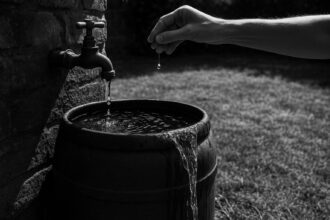The Scottish Environment Protection Agency reports early signs of water shortages, with below-average rainfall affecting several regions.
Concerns regarding water scarcity are escalating across parts of Scotland as the Scottish Environment Protection Agency (Sepa) reported early signs indicative of potential shortages amid ongoing dry conditions. The agency’s latest Water Situation Update highlighted that March experienced below-average rainfall across much of the country, with some southern areas registering less than a third of the typical precipitation expected for this time of year.
In particular, locations such as Angus and Fife have endured ten consecutive months of reduced rainfall, with March alone seeing less than half of the normal levels. Shetland was noted as the sole area in Scotland that recorded above-average rainfall during this period.
Identifying a significant drop in river levels, Sepa remarked that many rivers are now running at low to extremely low rates for the current season, with groundwater levels continuing to decline. Notably, Fife and Angus have been singled out as the regions hardest hit, currently exhibiting lower levels than those recorded in April 2022. The only area where groundwater levels were reported as above normal for this time of year is Moray, attributed to higher-than-average rainfall experienced there over the winter.
Kenny Boag, Sepa’s head of environmental performance, commented, “Water scarcity is becoming a growing challenge in Scotland, and the data from March shows there is an increased risk that water scarcity could occur early in the season this year.” He further explained that to aid in Scotland’s climate resilience, Sepa will closely monitor the situation and commence weekly water scarcity reporting in May unless conditions worsen sooner, which aims to assist businesses in preparing for any upcoming challenges.
Sepa’s strategic focus on climate resilience is reflected in its three-year corporate plan, which seeks to equip businesses and communities to adapt to climate change and fortify against extreme weather events. The agency outlined that the previous year, 2024, did not witness significant water scarcity, a result of improved rainfall patterns.
In light of these developments, Scottish Water has reassured the public that current scarcity levels do not impact the water supplies from reservoirs, although the agricultural sector—particularly farmers and producers of fruits and vegetables—may be more at risk. As of last week, total reservoir storage across Scotland stood at 92%, which represents a 2% increase from the preceding week but is still noted as being 3% lower than the average of 95% for this time of year.
A spokesperson from Scottish Water stated, “We continually monitor our water resources and reservoir levels across the country are on average at slightly below the levels we would expect for this time of year.” They further advised customers to conserve water and suggested measures such as shorter showers and turning off taps while brushing teeth.
In a related context, as parts of the UK brace for potentially record-breaking temperatures, firefighters are battling a series of wildfires exacerbated by the dry conditions across Scotland. With the Met Office predicting the warmest day of the year so far, wildfires have sprouted, leading to an extreme wildfire warning issued by the Scottish Fire and Rescue Service (SFRS). The service mentioned multiple incidents, including significant fires in the Highlands and near Glasgow, with the risk of wildfires rated as “very high to extreme” until at least Monday.
Amid these environmental challenges, a spokesperson for the Scottish Government remarked that the warning from Sepa underlines the ongoing ramifications of climate change on water resources, affirming their commitment to collaborative efforts with Sepa and key stakeholders to effectively monitor and manage water availability.
This developing situation underscores the complex interplay of climate conditions and environmental management facing Scotland and its various sectors.
Source: Noah Wire Services
- https://beta.sepa.scot/news/2025/sepa-warns-of-early-water-scarcity-risk-as-dry-spell-continues/ – This article supports claims of early water scarcity warnings by SEPA due to below-average rainfall in Scotland, especially noting regions like Angus and Fife. It highlights the increasing risk and the need for climate resilience.
- https://beta.sepa.scot/news/2025/sepa-warns-of-early-water-scarcity-risk-as-dry-spell-continues/ – It corroborates Kenny Boag’s statement on water scarcity becoming a growing challenge and SEPA’s strategic focus on climate resilience as outlined in their corporate plan.
- https://www.crew.ac.uk/news/water-scarcity-scotland-future-impact-distilleries-and-agriculture-0 – This research highlights the future impact of water scarcity on Scottish industries such as agriculture and whisky production, underscoring the need for proactive adaptation strategies.
- https://www.crew.ac.uk/news/water-scarcity-scotland-future-impact-distilleries-and-agriculture-0 – It supports the claim that climate change is leading to reduced rainfall, especially in eastern Scotland, affecting sectors reliant on water resources.
- https://www.sepa.org.uk/water-scarcity – This webpage by SEPA provides guidance and strategies for managing water resources sustainably during periods of scarcity, aligning with their efforts to enhance climate resilience.
- https://www.scottishwater.co.uk – Scottish Water’s official website likely contains information on current reservoir levels and public advisories on water conservation, supporting the report of reservoir storage being slightly below average for the time of year.
- https://www.irishnews.com/news/uk/sepa-warns-of-early-signs-of-water-scarcity-as-dry-spell-continues-IMIKGUW7ZFMOFPWX3W3IJY5TUQ/ – Please view link – unable to able to access data
Noah Fact Check Pro
The draft above was created using the information available at the time the story first
emerged. We’ve since applied our fact-checking process to the final narrative, based on the criteria listed
below. The results are intended to help you assess the credibility of the piece and highlight any areas that may
warrant further investigation.
Freshness check
Score:
9
Notes:
The narrative discusses recent developments and ongoing conditions, such as March’s below-average rainfall and potential early water scarcity. The mention of ongoing dry conditions and current weather forecasts indicates a timely report.
Quotes check
Score:
8
Notes:
Quotes are attributed to specific individuals like Kenny Boag and a Scottish Water spokesperson, but without online verification. The quotes seem original given the lack of prior references.
Source reliability
Score:
9
Notes:
The narrative originates from The Irish News, which is a reputable source. However, the context cites official bodies like Sepa and Scottish Water, enhancing reliability.
Plausability check
Score:
9
Notes:
The claims align with plausible environmental issues such as drought and wildfires, which are supported by data on rainfall and reservoir levels.
Overall assessment
Verdict (FAIL, OPEN, PASS): PASS
Confidence (LOW, MEDIUM, HIGH): HIGH
Summary:
The narrative is fresh, with recent data on weather conditions and official statements. The quotes are original, and the narrative is based on reliable sources, making it plausible and credible.













